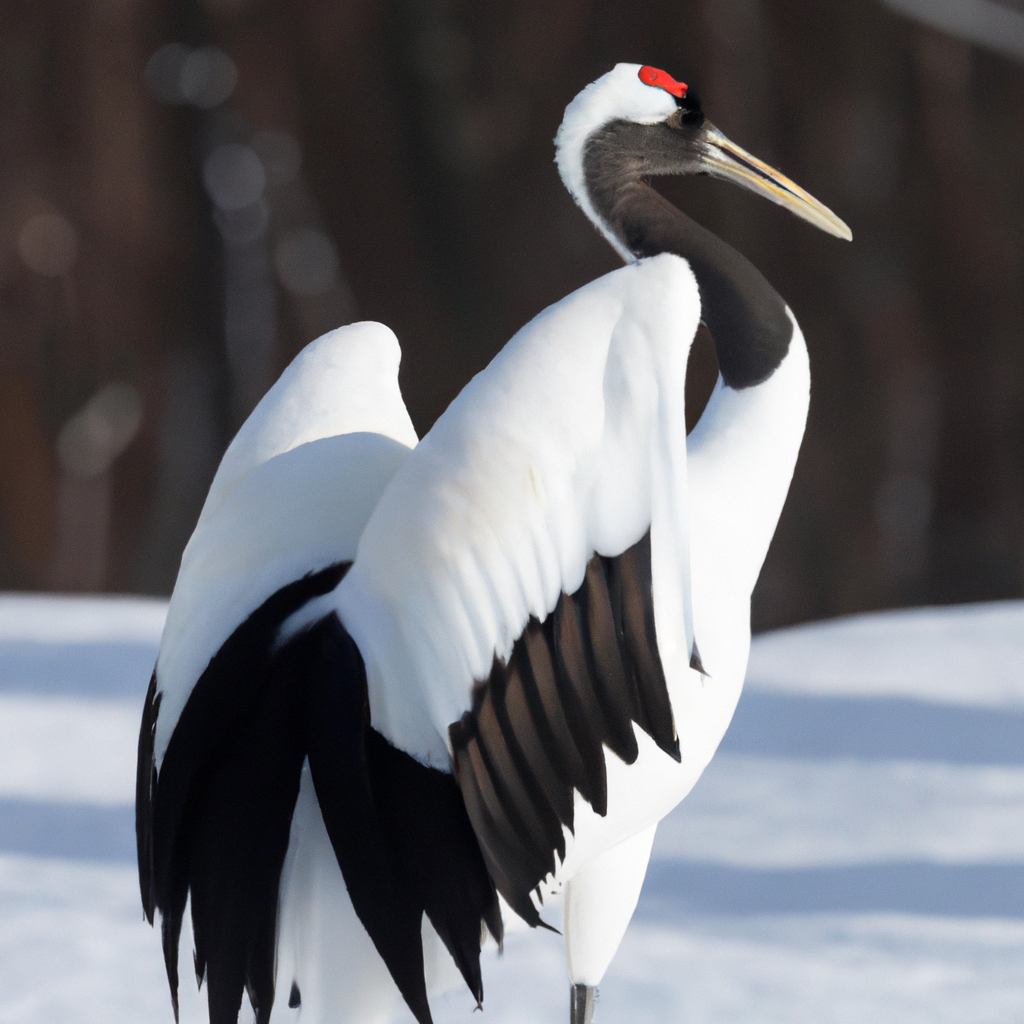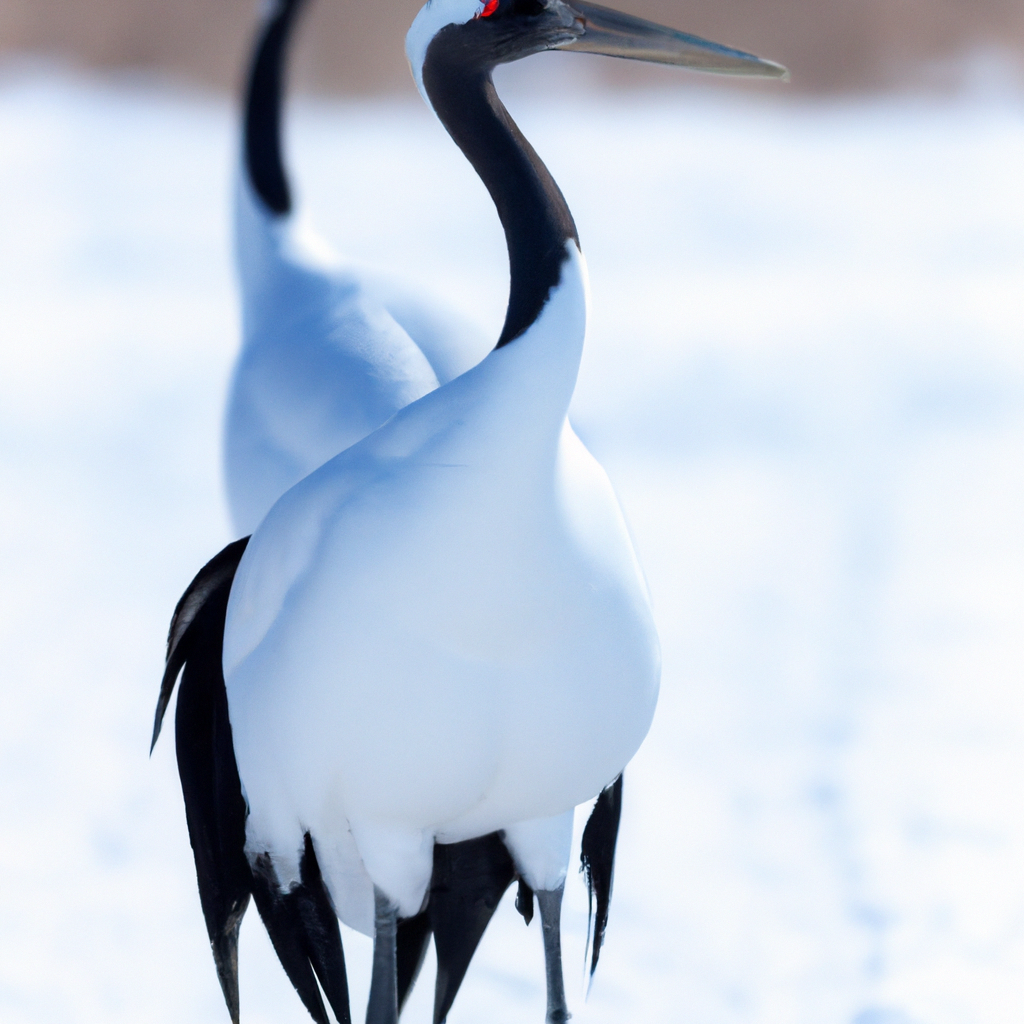The Red-crowned Crane (Grus Japonensis) is an iconic bird species that captivates both researchers and nature enthusiasts alike. This magnificent crane, also known as the Japanese Crane, is highly regarded for its elegance and distinct appearance. With its striking red crown atop a snowy white body, the Red-crowned Crane stands as a symbol of grace and beauty. Endemic to East Asia, this endangered species holds great cultural significance in countries like Japan and Korea. However, its population faces numerous threats, such as habitat loss and poaching. In this article, we will explore the fascinating world of the Red-crowned Crane, shedding light on its characteristics, conservation efforts, and the importance of preserving this majestic bird species for future generations.
Physical characteristics
Appearance
The Red-crowned Crane is an elegant and majestic bird with unique physical characteristics. It stands tall and upright, with a height of around 5 feet (1.5 meters). Adults have a wingspan of approximately 7 to 8 feet (2.1 to 2.4 meters), making them one of the largest species of crane in the world. These cranes have a slim, slender body with long legs and a long, graceful neck.
Size
The Red-crowned Crane is known for its impressive size. Adults weigh between 15 to 26 pounds (7 to 12 kilograms), with males typically being larger and heavier than females. These cranes are often recognized for their striking resemblance to the majestic elegance of the Japanese kimono, with their pristine white plumage and bold, red crown atop their head.
Coloration
The Red-crowned Crane is predominantly white, showcasing a pristine and elegant plumage. However, the crown on their head is a vibrant shade of red, contrasting beautifully against the white feathers. This red crown extends from the forehead and covers the top of the head, adding to the bird’s regal appearance. The wings of the Red-crowned Crane are primarily black, with some feathers also featuring shades of gray.
Habitat and distribution
Breeding grounds
The Red-crowned Crane primarily breeds in northeastern Asia, specifically in the regions of Russia, China, and Japan. In Russia, they are found in the Amur River basin, while in China, their breeding grounds extend to Heilongjiang and Zhejiang provinces. In Japan, they breed mainly on the island of Hokkaido. The cranes prefer wetlands and marshy areas for their breeding habitats as they provide an abundance of food and nesting sites.
Wintering grounds
During the winter months, these cranes migrate to seek warmer climate and abundant food sources. They typically fly southward to areas such as eastern China and the Korean Peninsula. In China, they can be found in provinces like Jiangsu and Shandong, while in Korea, they are observed in regions like Cheorwon and Seosan.
Migration patterns
Red-crowned Cranes are known for their remarkable migratory journeys. They undertake extensive flights, covering long distances between their breeding and wintering grounds. The cranes travel in a V-formation, maximizing their energy by taking advantage of the uplift produced by the birds in front of them. These migratory journeys can span thousands of kilometers and are critical for their survival as they ensure access to suitable breeding and wintering habitats.

This image is property of images.unsplash.com.
Diet and feeding habits
Primary food sources
The Red-crowned Crane has a varied diet, which mainly consists of plants, insects, small mammals, and amphibians. In their breeding grounds, they feed on a range of wetland vegetation, including sedges, grasses, and aquatic plants. During the winter months, when wetlands may be frozen or scarce, these cranes adapt their diet and consume crops such as barley, corn, and potatoes. Despite their large size, they are also skilled hunters and can catch small mammals like rodents, fish, and even frogs.
Feeding behavior
Red-crowned Cranes are opportunistic feeders, possessing a unique way of foraging. They use their long, slender bills to probe the soil, shallow water, or vegetation in search of food. These cranes are often seen performing beautiful, dance-like movements while foraging, gracefully extending their wings and hopping across the wetland habitat. This behavior not only aids in their hunting but also captures the attention of potential mates during courtship displays.
Reproduction and lifecycle
Breeding season
The Red-crowned Crane has a distinct breeding season that varies depending on the location. In general, breeding season takes place between April and August. The exact timing may be influenced by factors such as food availability and weather conditions. During this period, the cranes engage in elaborate courtship rituals to form pair bonds and prepare for nesting.
Courtship displays
The courtship displays of Red-crowned Cranes are a sight to behold. Males and females engage in an intricate dance ritual, symbolizing their intentions and strengthening their bond. They leap and dance together, stretching their wings, bowing, and calling out in unison. These displays are not only visually striking but also serve to establish the pair’s compatibility and readiness for breeding.
Nesting behavior
Red-crowned Cranes build their nests in wetland habitats, particularly in areas with tall vegetation that provides cover and protection. They construct large nests on the ground, using reeds, grasses, and other plant materials. The nests are typically elevated to protect the eggs from potential flooding or predation. The female lays one to two eggs, and both parents take turns incubating them for a period of approximately 29 to 35 days. After hatching, the parents diligently care for their young, providing them with warmth, protection, and food until they are capable of fledging.

This image is property of images.unsplash.com.
Conservation status and threats
Population size and trends
The Red-crowned Crane is currently listed as an endangered species. While exact population numbers are difficult to determine, it is estimated that there are only around 3,000 of these cranes left in the wild. Their numbers have significantly declined over the years due to various factors, including habitat loss, human disturbance, and illegal hunting. Conservation efforts are crucial to protect and restore their populations.
Habitat loss and degradation
Habitat loss and degradation are significant threats facing the Red-crowned Crane. Wetland habitats, vital for their survival, are being drained and converted for agriculture, industrial development, and urbanization. Furthermore, pollution and water contamination degrade the quality of the remaining habitats, making them less suitable for the cranes.
Human impact and disturbance
Human activities pose a serious threat to the Red-crowned Crane. Disturbance from human presence, especially around their breeding grounds, can disrupt their courtship displays, nesting, and foraging behaviors. Additionally, illegal hunting and the collection of eggs for trade further exacerbate the population decline. It is essential to raise awareness and enforce protective measures to minimize these harmful impacts.
Cultural importance and symbolism
Traditional significance
The Red-crowned Crane holds deep cultural significance in many countries, particularly Japan and Korea. In Japanese culture, these cranes are regarded as symbols of luck, longevity, and fidelity. They are often depicted in traditional artwork, including paintings, pottery, and fabrics. The presence of Red-crowned Cranes in an area is considered auspicious and brings blessings to the community.
Conservation efforts
Recognizing the importance of the Red-crowned Crane, various conservation efforts have been initiated to protect this iconic species. International collaboration between governments, organizations, and local communities is working towards creating protected areas, implementing conservation strategies, and raising awareness about the importance of preserving their natural habitats.
Cultural depictions
The Red-crowned Crane is a beloved subject in many cultural depictions. They are frequently featured in folklore, literature, and poetry, symbolizing grace, beauty, and immortality. In traditional Japanese dance, the graceful movements of these cranes are often emulated, highlighting their cultural significance and inspiring artistic expressions.

This image is property of images.unsplash.com.
Interaction with humans
Human-wildlife conflicts
The interaction between Red-crowned Cranes and humans can lead to conflicts. The destruction of wetland habitats for agriculture and urban development can displace the cranes from their natural habitats, forcing them to adapt to new and potentially less suitable environments. Additionally, cranes may cause damage to crops, which can lead to conflicts with local communities.
Conservation initiatives
Numerous conservation initiatives aim to mitigate human-wildlife conflicts and promote harmonious coexistence. Developing sustainable agricultural practices that minimize the detrimental impacts on crane populations is crucial. Furthermore, educational programs can raise awareness among local communities about the importance of conserving cranes and their habitats.
Economic benefits
The presence of Red-crowned Cranes can also bring economic benefits to local communities through nature-based tourism. These charismatic birds attract visitors from around the world, supporting local economies and providing incentives for conservation efforts. Well-managed eco-tourism can create opportunities for income generation while promoting the conservation of these magnificent birds.
Interesting facts
Longevity
Red-crowned Cranes have impressive lifespans, with some individuals surviving for over 30 years in the wild. Their longevity is a testament to their adaptability and resilience, as well as the importance of conservation efforts in ensuring their survival.
Flight and vocalizations
When in flight, Red-crowned Cranes showcase their majestic wingspan and powerful wingbeats. Their calls are distinct and melodious, often described as a combination of bugle-like calls and trumpeting, carrying over long distances. These vocalizations are not only used for territorial communication but also serve as a bonding mechanism during courtship displays.
Symbol of immortality
In East Asian cultures, Red-crowned Cranes are associated with the concept of immortality. Their longevity, gracefulness, and regality have inspired beliefs that these cranes possess mystical powers and are capable of living for thousands of years. They are often depicted alongside deities and revered as symbols of immortality and eternal youth.

Similar species
Hooded crane
The Hooded Crane (Grus monacha) is a closely related species to the Red-crowned Crane. It is slightly smaller in size and has a distinctive black “hood” covering its head and neck. The Hooded Crane can be found in similar geographical regions and shares some aspects of its habitat and behavior with the Red-crowned Crane.
White-naped crane
The White-naped Crane (Grus vipio) is another species closely related to the Red-crowned Crane. It has a brownish-gray plumage and a white patch on the back of its neck. While sharing some habitat preferences with the Red-crowned Crane, the White-naped Crane tends to breed in different areas and has a distinct courtship display.
Siberian crane
The Siberian Crane (Leucogeranus leucogeranus) is a critically endangered species that is often confused with the Red-crowned Crane due to their white plumage. However, the Siberian Crane has a larger and more robust build, with black wingtips and a striking red face. These cranes have overlapping migration routes and wintering grounds with the Red-crowned Crane.
Conclusion
The Red-crowned Crane, with its stunning appearance and cultural significance, is an iconic species at risk of extinction. Habitat loss, human disturbance, and illegal hunting pose significant threats to these majestic birds. However, through dedicated conservation efforts and international collaboration, there is hope for their preservation. Protecting their wetland habitats, raising awareness, and engaging local communities are vital steps toward ensuring the survival of this extraordinary species for future generations to admire and appreciate.

